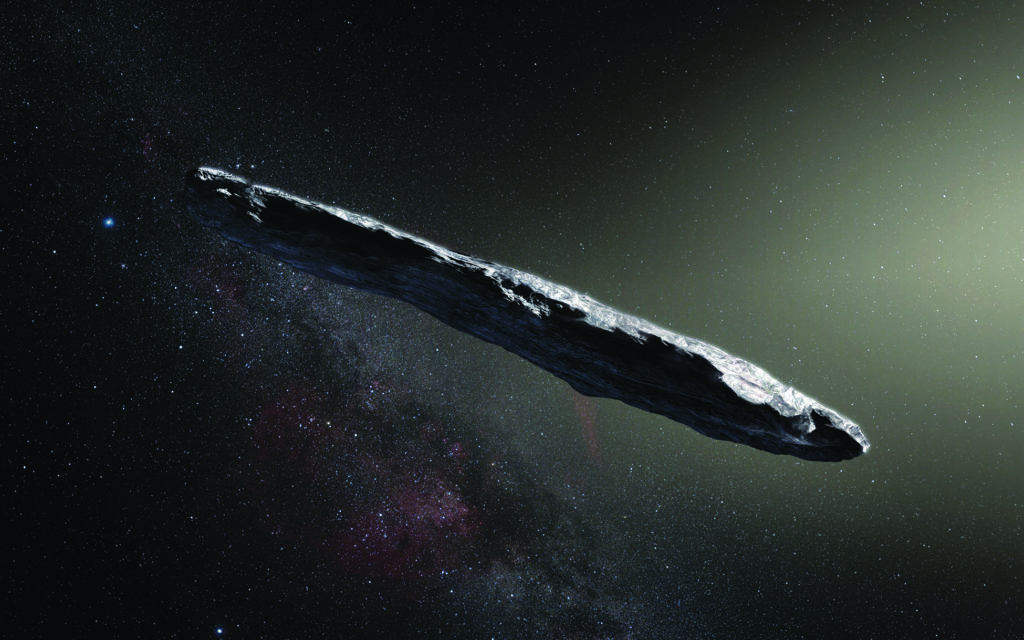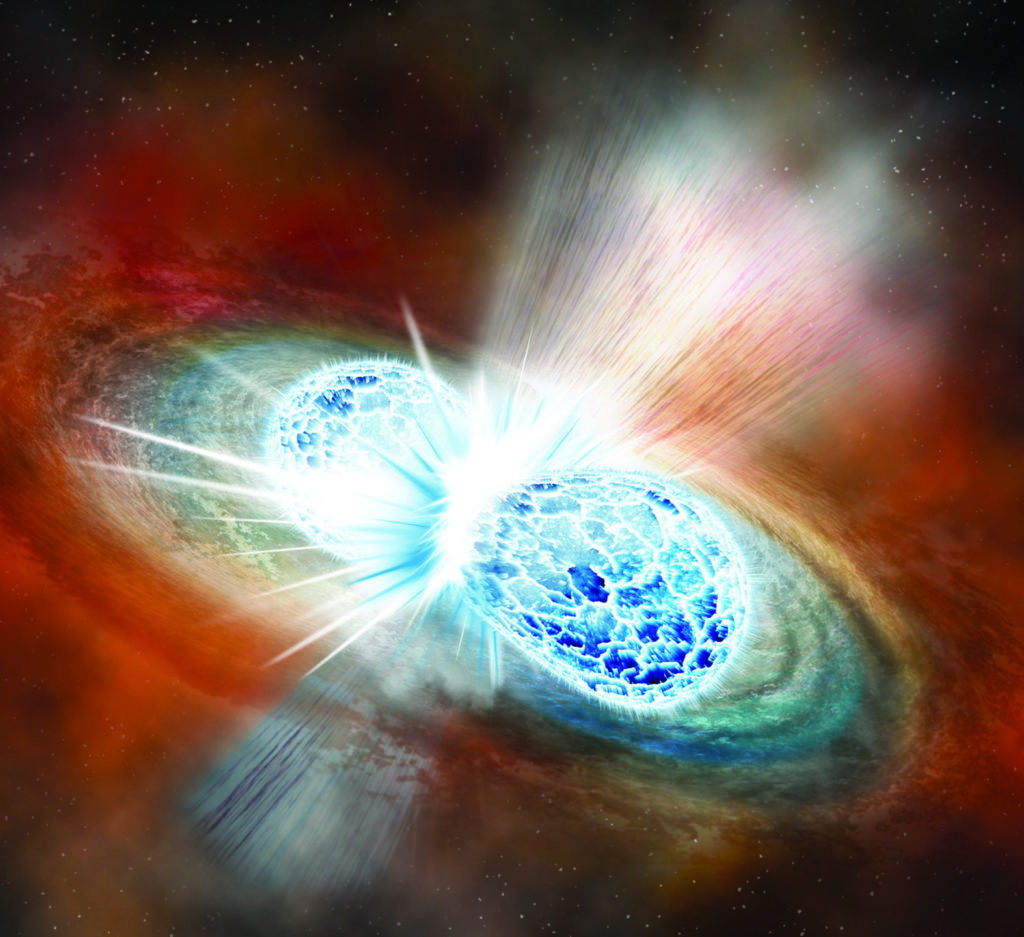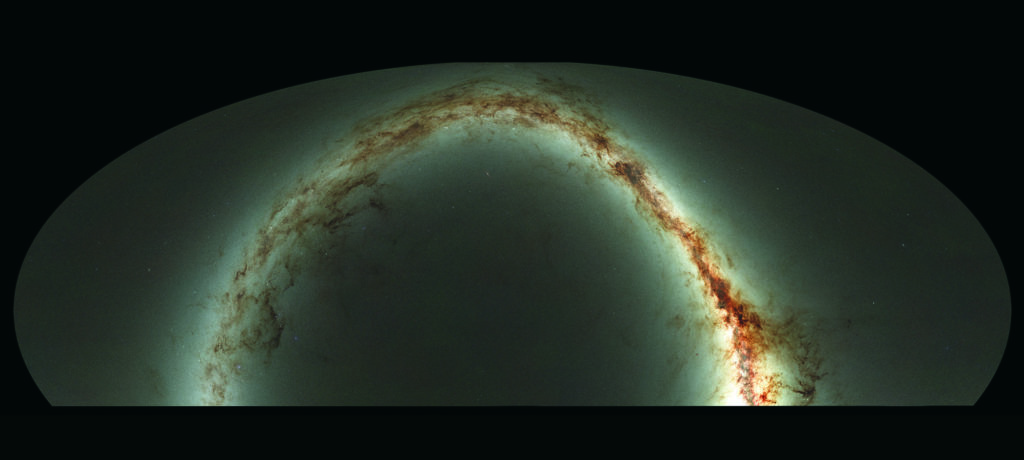Hunting for Killer Asteroids and Surveying the Sky with UH’s Pan-STARRS
While the threat has always existed, disaster movies like Deep Impact and Armageddon in the late 1990s created a greater public interest in the sky above and the potential of near-earth object (NEO) impacts—primarily asteroids, with the Earth. Rather than leave it to a chance observation, NASA has been actively studying NEOs since the 1970s and later began tracking asteroids and comets through a coordinated network of ground- and space-based telescopes in its Near-Earth Objects Observations Program.
A key player in this network is duo of unique telescopes developed by the Institute for Astronomy (IfA) at the University of Hawai‘i at Mānoa (UH Mānoa) called the Panoramic Survey Telescope & Rapid Response System (Pan-STARRS). Located near the summit of Haleakalā on the island of Maui, The Pan-STARRS1 Telescope (PS1) began full operations in 2010 and the adjoining Pan-STARRS2 Telescope (PS2) is expected to become operational later this year.

“While Pan-STARRS1 is comparatively smaller than the 4-meter mirror on the neighboring Daniel K. Inouye Solar Telescope or the 10-meter telescope at the Keck Observatory on Mauna Kea, its 1.8-meter telescope makes up for it with the field of view and camera,” said Dr. Ken Chambers, director of the Pan-STARRS Observatories. “Our telescope is equipped with special optics that provide a very wide view—three degrees across, the equivalent of an angular view of six full moons aligned in a row. Pan-STARRS1 is also equipped with a 1.4-gigapixel digital camera—currently the world’s largest operationally.”
In a single night, Pan-STARRS1 will take over 500 photos of the night sky in different wavelength bands and transfer about a terabyte of astronomical data to the Pan-STARRS cluster in the Information Technology Center, the largest dedicated civilian computing system in Hawai‘i, located on the UH Mānoa campus. Here the processing and analysis of the data begins with the Image Processing Pipeline (IPP), a highly parallelized and specialized computing system developed by the Pan-STARRS team, to “clean” the raw images of unwanted instrumental signatures and optical distortions. From there, the new images are photometrically calibrated against “historical” images found in the Pan-STARRS catalog. By comparing images of the same section of sky taken on multiple dates, astronomers can look for subtle changes or “difference images,” that would indicate a moving, variable or new transient object.
Utilizing this method, Pan-STARRS1 has identified more moving objects than the rest of the worlds telescopes combined—over 4,000 Near Earth Objects, hundreds of new comets and hundreds of Trans-Neptunian or Kuiper Belt Objects. It has also identified over 7000 transient objects, including a surprising zoo of new kinds of supernovae and even Tidal Disruption Events—the dying flare from a star ripped apart by tidal forces as it spirals into a black hole.
Discovery of the First Interstellar Object
On October 19, 2017, Pan-STARRS1 was the first to detect an unusual visitor whose motion and speed were not consistent with a normal solar system object or comet orbit.
Later named, ‘Oumuamua or “messenger from afar, arriving first” in Hawaiian, the asteroid or comet was the first interstellar object ever detected passing through the Solar System.
From data it obtained from Pan-STARRS1 and other observatories around the world, NASA’s Center for Near-Earth Object Studies plotted that ‘Oumuamua came from the direction of the constellation Lyra at speed of 15.8 miles per second. It approached the Solar System from almost directly above the ecliptic orbits of the planets, made a close approach to the Sun diving under the ecliptic plane and finally was pulled up by the Sun’s gravity passing below the Earth’s orbit at a distance of about 15 million miles at a new speed of 27 miles per second on its way toward the constellation Pegasus.
“We have long suspected that these objects should exist, because during the process of planet formation a lot of material should be ejected from planetary systems,” said Dr. Karen Meech, an astronomer at IfA specializing in small bodies and their connection to solar system formation. “What’s most surprising is that we’ve never seen interstellar objects pass through before.”

Credit: ESO/M. Kornmessier

Confirmation of a Kilonova
On August 11, 2017, Pan-STARRS1 was called upon again to scan a location in the sky where astronomers in the U.S. and Chile had earlier detected strange bursts of energy being emitted. Through a comparison of new images and previous images of the source taken by Pan-STARRS1, it was confirmed that the initial brightness of the area was dimming rapidly.
“A new astronomical object fading this fast was unheard of,” said Chambers. “This was the signature of a kilonova and the Pan-STARRS Team with their precision photometry alerted the world to its unique signature.”
A kilonova occurs when two collapsed neutron stars, devoid of any energy, circle toward each other in a “death spiral” and collide in spectacular fashion sending cosmic debris hurtling into space. In this first witnessed event, the object changed from a blue, to red and finally into a spectrum that was never seen before—indicating the presence of heavy elements.
“It was long believed that these heavy elements came from single massive stars exploding in a supernova long before our solar system was formed,” said Chambers. “As a result of this event, astronomers believe that it will change our understanding of how each family of isotopes are created and the emergence of the periodic table of the elements over cosmic history.”
World’s Largest Digital Sky Survey
From 2010 to 2014, Pan-STARRS1 collected data on three billion separate sources, including stars, galaxies, asteroids, quasars, white dwarfs, brown dwarfs and various other objects. Known as the Pan-STARRS1 Surveys, the collection contains two petabytes of data, equivalent to 100 times the total content of Wikipedia, and can be used in a wide range of applications to assist the astronomical community. In 2016, Pan-STARRS/IfA and the Space Telescope Science Institute released “Static Sky,” which is the average of each of those individual epochs (a date in time used as a reference point to predict the movements of a celestial body). Later this year, the second data set providing a catalog that gives the information and images for each individual epoch will be released in the largest astronomical data release in history. Ongoing releases will continue with new data and more detailed maps in the years ahead.
“The Pan-STARRS1 Surveys allow anyone to access millions of images and use the database and catalogs containing precision measurements of billions of stars and galaxies,” said Chambers. “The rest of the world now uses Pan-STARRS to calibrate their data, as it has become the standard by which other systems are compared to.”
Having spent years of effort developing, refining and expanding the Pan-STARRS System, Chambers and his team are now poised to reap the benefits with new, and as yet, unknown discoveries—while continuing to map the universe and quietly serving as guardians of the Earth.


